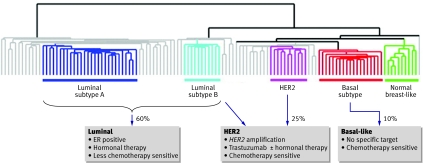Fig 1 Diagram showing how breast cancer subtypes influence treatment. Breast tumours at the molecular level cluster into three main subtypes of cancer: luminal-type (with subtypes A and B), HER2, and basal-like. Luminal-type breast cancers express the oestrogen receptor (ER) and related genes and can be targeted with hormonal therapies; the less aggressive (subtype A) cancers may be less sensitive to chemotherapy than the more aggressive (type B) cancers. HER2 breast cancers, characterised by overexpression of the growth factor receptor HER2 with amplification of the HER2 gene, are aggressive with a poor prognosis. HER2 positive cancers can be targeted with the monoclonal antibody trastuzumab and also may be highly chemotherapy sensitive. About half of HER2 positive cancers express the oestrogen receptor. Basal-like cancers do not usually express either of the hormone receptors (oestrogen or progesterone) or overexpress the growth factor receptor HER2, a phenotype named “triple negative.” Basal-like cancers are highly proliferative and have a poor prognosis, although many are highly sensitive to chemotherapy. There is no subtype specific targeted therapy. (The clustering of genome-wide gene expression analysis is adapted from Sorlie et al1)

An official website of the United States government
Here's how you know
Official websites use .gov
A
.gov website belongs to an official
government organization in the United States.
Secure .gov websites use HTTPS
A lock (
) or https:// means you've safely
connected to the .gov website. Share sensitive
information only on official, secure websites.
